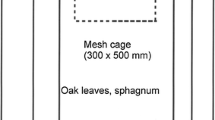Abstract
The activity of larvalI. ricinus was studied in the field and on experimental plots in an attempt to determine the origin and population dynamics of larvae at different times of the year. A comparison of sampling methods showed that the previously observed small size of the spring peak relative to the midsummer peak is not a sampling artifact and is a genuine measure of the prevalence of active larvae. It was established that spring-active larvae are derived from spring-fed adults which contribute comparatively few larvae to the midsummer peak. The small size of the spring peak is probably due to relatively poor activation and survival of available larvae at this time. A distinct emergence and activation of larvae, almost certainly derived from autumn-fed adults, was detected in July, which is before the diapause period. Such larvae would be capable of producing spring nymphs and this is probably a major means of transfer of ticks between spring and autumn populations.
Similar content being viewed by others
References
Barnett, S.F., 1967. The biology and breeding cycle ofIxodes ricinus in south-eastern England. In: G.O. Evans (Editor), Proceedings of the 2nd International Congress of Acarology, Akademiai Kiado, Budapest, p. 599.
Gray, J.S., 1981. The fecundity ofIxodes ricinus L. and the mortality of developmental stages under field conditions. Bull. Entomol. Res., 71: 533–542.
Gray, J.S., 1982. The development and questing activity ofIxodes ricinus L. under field conditions in Ireland. Bull. Entomol. Res., 72: 263–270.
Gray, J.S., 1984. Studies on the dynamics of active populations of the sheep tick,Ixodes ricinus, in Co. Wicklow, Ireland. Acarologia, 25: 167–178.
Gray, J.S., 1985. A carbon dioxide trap for prolonged sampling ofIxodes ricinus L. populations. Exp. Appl. Acarol., 1: 35–44.
Gray, J.S. and Lohan, G., 1982. The development of a sampling method for the tickIxodes ricinus and its use in a redwater fever area. Ann. Appl. Biol., 101: 421–427.
Gray, J.S., Turley, T. and Strickland, K.L., 1978. Studies on the ecology of the sheep tick,Ixodes ricinus, in Co. Wicklow, Ireland. Ir. Vet. J., 32: 25–34.
Nosek, J., 1978. The effects of microclimate onIxodes ricinus. In: T.E. Gibson (Editor), Weather and Parasitic Animal Disease. W.M.O. Tech. Note 159, pp. 105–116.
Simon, P.H., Rancien, P. and Euzeby, J., 1974. Bovine babesiosis endemic in the Charollais district. Second note: epidemiological study and conclusions on prophylaxis. Bull. Soc. Sci. Vet. Med. Comp. Lyon, 76: 411–421.
Sonenshine, D.E., 1978. Radiant energy and tick activity. In: T.E. Gibson (Editor), Weather and Parasitic Animal Disease. W.M.O. Tech. Note 159, pp. 117–125.
Walton, G.A. and O'Donnell, T.G., 1976. Observations onIxodes ricinus and louping-ill virus in Ireland. In: G.O. Evans (Editor), Proceedings of the 2nd International Congress of Acarology, Akademiai Kiado, Budapest, pp. 601–608.
Wilson, J.G., Kinzer, D.R., Sauer, J.R. and Hair, J.A., 1972. Chemo-attraction in the Lone Star tick (Acarina: Ixodidae). 1. Response of different developmental stages to carbon dioxide. J. Med. Entomol., 9: 245–252.
Author information
Authors and Affiliations
Rights and permissions
About this article
Cite this article
Gray, J.S. Studies on the larval activity of the tickIxodes ricinus L. in Co. Wicklow, Ireland. Exp Appl Acarol 1, 307–316 (1985). https://doi.org/10.1007/BF01201570
Accepted:
Issue Date:
DOI: https://doi.org/10.1007/BF01201570




